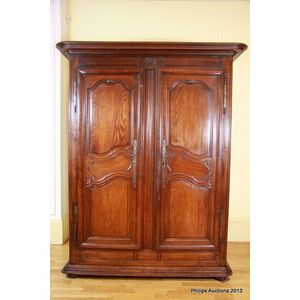Regence Style Oak Drinks Cabinet with Mirrored Slide
You must be a subscriber, and be logged in to view price and dealer details.
Subscribe Now to view actual auction price for this item
When you subscribe, you have the option of setting the currency in which to display prices to $Au, $US, $NZ or Stg.
- Oak - Native to Europe and England, oak has been used for joinery, furniture and building since the beginning of the medieval civilisation. It is a pale yellow in colour when freshly cut and darkens with age to a mid brown colour.
Oak as a furniture timber was superceded by walnut in the 17th century, and in the 18th century by mahogany,
Semi-fossilised bog oak is black in colour, and is found in peat bogs where the trees have fallen and been preserved from decay by the bog. It is used for jewellery and small carved trinkets.
Pollard oak is taken from an oak that has been regularly pollarded, that is the upper branches have been removed at the top of the trunk, result that new branches would appear, and over time the top would become ball-like. . When harvested and sawn, the timber displays a continuous surface of knotty circles. The timber was scarce and expensive and was used in more expensive pieces of furniture in the Regency and Victorian periods. - Hardware - A general term applied to the metal fittings on an item of furniture, such as locks, hinges and handles. Whilst most furniture will usually have brass hardware as it does not rust, some earlier rustic objects such as coffers sometimes have iron hardware.
- Cabriole Leg - The cabriole leg evolved from an elongated scroll, curving out at the knee which may or may not be carved, and forming a serpentine shape as it descends to the foot.
First introduced into English furniture in the late 17th century, cabriole legs were widely used during the Queen Anne and early Georgian periods, where they frequently terminated in a pad foot or ball and claw foot. The style has had many imitators since then. The cabriole leg was re-introduced in the mid-19th century, and is commonly associated with the balloon-back dining or drawing-room chairs made in walnut, mahogany or, in Australia, cedar. The Victorian cabriole leg, on the whole, was rather more slender than the earlier form, following the French style, which emphasized the delicacy and daintiness of the chairs they were designed to support. Cabriole legs are sometimes found on windsor chairs, especially those made during the 18th century. - Fielded Panel - A recessed panel, where the outer edges have been bevelled or chamfered. The central section of the panel is thus raised or 'fielded'. The field may follow a variety of shapes square, rectangular, rounded or shield shaped. Fielded panels are found on many cabinet doors made over the past several centuries. On some chests, the drawer fronts may also be fielded
- Panels - Timber pieces, usually of well-figured wood either recessed or applied over the frames of doors and as decoration elsewhere in the carcase of cabinet furniture. The panels may take a variety of shapes rectangular, square, shield shape, oval, half-round or in the form of Egyptian pylons.
This item has been included into following indexes:
Visually similar items

French Louis XV style cherry wood two door, three drawer buffet, approx 91 cm high, 138 cm wide, 48 cm deep

A French two door single drawer sideboard 96 cm high, 142 cm wide, 59 cm deep

A Louis XVI provincial oak armoire, late 18th century, the moulded cornice and carved frieze above a pair of well-moulded double-panelled doors flanked by fluted corners, the base moulding above flattened bun feet, the sides panelled, with decoratively sha

A French provincial fruitwood buffet, late 18th century. 96 cm high, 134 cm wide, 59 cm deep
